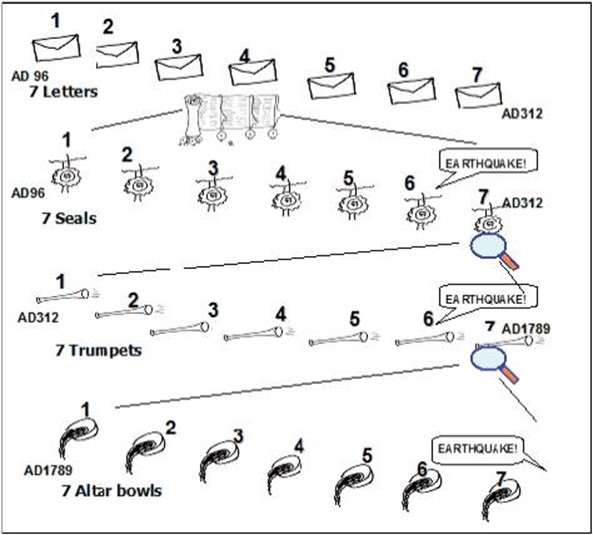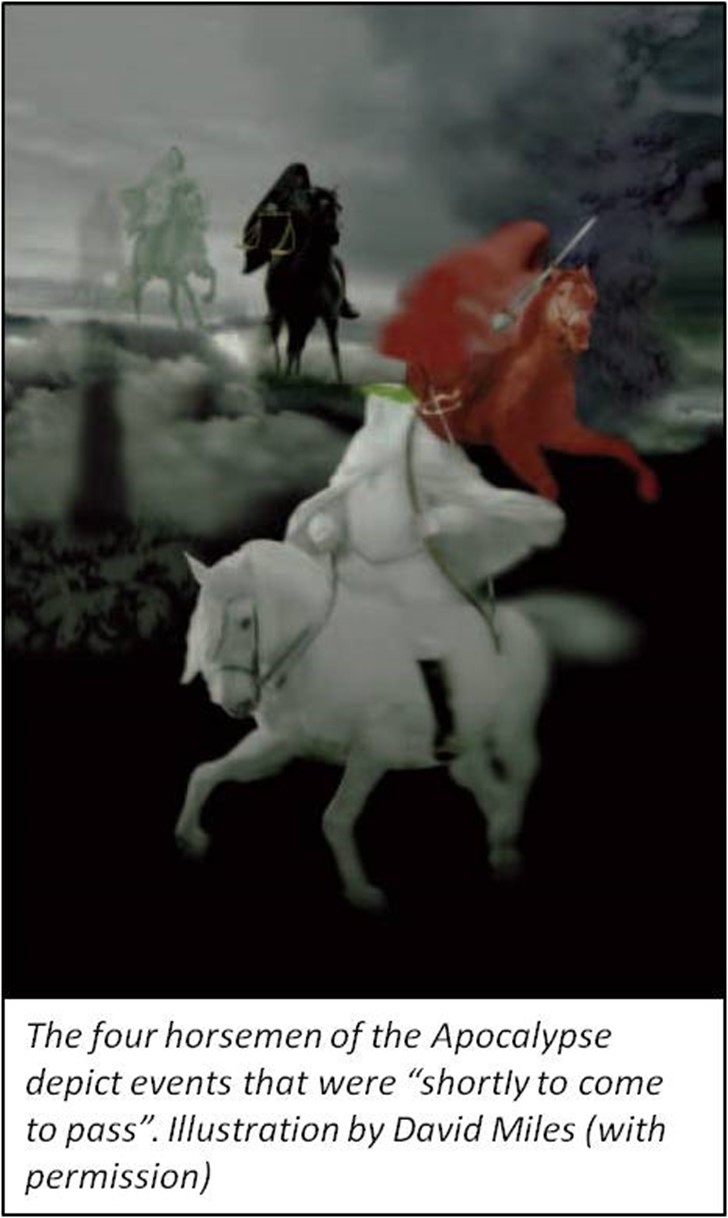
The Book of Revelation Explained – Part 1
 This last book of the Bible was penned by the apostle John, probably towards the end of the First Century. He writes in a time of persecution, when he has been sent into exile by the Roman authorities, marooned on the island of Patmos “on account of the word of God and the testimony about Jesus” (Revelation 1:9). Patmos is a tiny island off the coast of Turkey, about 13 square miles (34 square kilometers) in area.
This last book of the Bible was penned by the apostle John, probably towards the end of the First Century. He writes in a time of persecution, when he has been sent into exile by the Roman authorities, marooned on the island of Patmos “on account of the word of God and the testimony about Jesus” (Revelation 1:9). Patmos is a tiny island off the coast of Turkey, about 13 square miles (34 square kilometers) in area.
Inspired Visions
The Revelation is the record of a series of inspired visions in which John sees and hears his Master Jesus talking to him, passing on a message for the Christian brothers and sisters. The opening verse is important – “The Revelation of Jesus Christ, which God gave him to show His servants—things which must shortly take place” (Revelation 1:1).
In doing this we are told that this message of the future of mankind ie. the rise and fall of world powers and governments, was revealed to John in a symbolic way ie. in Revelation 1:1 it goes on to say that “he (Christ) sent and signified it by his angel unto his servant John.”
The symbols used are the same as those found in earlier prophecies in Isaiah, Ezekiel and Daniel. So in understanding Revelation we much first appreciate this way in which it was written and that much of what we read is a symbol of a future power and powers to arise and that the depictions of them and the events they would bring about are not to be interpreted in a literal sense but by the symbols used.
The vision was to show John things that must take place, so it was a prophecy, like the prophecies of Isaiah, Jeremiah, Ezekiel and Daniel. It predicted the course of events far into the future, so that God’s servants would be prepared and strengthened in times of persecution, knowing that world events are in God’s hands, and move steadily towards the goal of His Kingdom being established on earth.
To appreciate the book of Revelation we need to have read the rest of the Bible first, because it is full of links and allusions to the earlier writings. Practically every phrase and theme has been plucked from the Old Testament (in some cases the New Testament), and applied to a new but similar situation.
We will find strong links to the visions of the prophet Daniel, who saw four amazing beasts with features that foretold the course of history from his day up to the First Century. John’s visions take over where Daniel’s left off, and we shall meet Daniel’s beasts in a new guise, used this time to predict the events of European history through many centuries.
Perfect Number
A key idea in the Revelation is the number seven. Seven is the perfect number, the cycle of days that completes a week and then starts again.
The book is divided into groups of sevens – seven lampstands and seven letters, seven wax seals on a scroll, seven trumpets that blow in turn, and seven altar bowls poured out on the earth.
There is another twist – seven in seven. This concept comes from the conquest of Jericho by Joshua.
The soldiers of Israel marched round the city of Jericho once a day for six days. But on the seventh day they marched round seven times, and on the 13th circuit, the walls collapsed and the city fell. So in the Revelation there are six seals, but when the seventh is cut through it is found to enclose the seven trumpets, and when the seventh trumpet begins to blow it conceals the seven bowls. Only when we reach the seventh bowl does the Kingdom of God finally arrive in all its glory.
Here is a schematic diagram which illustrates the way the book of Revelation is laid out in sets of sevens:
Unfolding Drama
In the opening chapter John sees his master, the Lord Jesus, in heavenly glory. Jesus is walking amongst seven golden lampstands, which John is told represent seven Christian congregations in the province of Asia. Each in turn is given a written report, dictated to John, outlining their successes and their weak points, just like the traditional end-of-term report at school. Each letter ends with a beautiful promise, held out to “him who conquers”.
 It is a surprise to find seven churches in the same area with such a variation in their spiritual health, from Ephesus – patiently enduring and bearing up for Jesus’ sake; to Laodicea – smug and complacent, but in Jesus’ view close to death (see Revelation 1:11 to 3:22).
It is a surprise to find seven churches in the same area with such a variation in their spiritual health, from Ephesus – patiently enduring and bearing up for Jesus’ sake; to Laodicea – smug and complacent, but in Jesus’ view close to death (see Revelation 1:11 to 3:22).
At this point John is invited to come up into heaven so that he can watch history unfold before his eyes.
Unlike the Seven Letters, which were sent to his contemporaries, the rest of Revelation relates to events after John’s lifetime. To understand the setting from this point onwards, we need to imagine a drama, a historical pageant acted out as a series of scenes on the stage of a theatre. John the observer is invited up into the royal box for the performance.
Looking down, he sees the earth and the sea below him.
As each act is announced, the characters come and go, accompanied by appropriate sound effects. As an added refinement, the ‘royal box’ is defined in chapter four as the Temple from the Old Testament, complete with:
❖an Ark (the ‘throne’ on which God’s angel once sat as His representative),
❖an incense altar, an altar for sacrifices,
❖a great reservoir or ‘sea’ for water,
❖a lampstand, and
❖four cherubim or ‘living creatures’.
He also sees in the foreground 24 elders, who serve the Lord as did the 24 orders of Levites in the Temple of Solomon.
The Scroll Opened
In the opening scene, John sees the Lord God, seated on the throne, holding a scroll in his hand. It is made up of seven sections, each separately sealed with a string and a wax pendant. Nobody could read the scroll until the strings were cut. John sees a wounded Lamb approach the throne. It is Jesus, the Lamb of God, and he is given the right to open the scroll.
He cuts the first string, and as the scroll flies open a white horse gallops across the stage with a warrior on his back. The next seal introduces a red horse ridden by a man with a dagger.
with a warrior on his back. The next seal introduces a red horse ridden by a man with a dagger.
The third horse is black. His rider carries scales for weighing out daily food rations. The fourth is the colour of a corpse, and the skeleton on its back is accompanied by a symbolic grave, shovelling up the dead over a quarter of the earth.
Four Horsemen
The four coloured horses are taken from the Old Testament prophet Zechariah. It is not difficult to line up the four seals with the history of the Roman Empire after John’s death – an initial period of prosperity and peace, followed by civil war, then famine and pestilence, especially in the Italian division of the Empire, which was divided into four quarters at this time. The time period covers AD 100 to AD 270.
The next Seal introduces an altar said to represent the lives of Christian believers. Many of them were indeed martyred for their faith by the pagan (idol worshipping) Emperor Diocletian around 300 AD.
The Sixth Seal opens with dramatic sound-effects – an earthquake, and the removal of the sun, moon and stars – a traditional Bible symbol for a change of rulership.
This links with the revolutionary change that took place when Constantine battled successfully for control of the Empire. Pagan Rome became Christian Rome as he removed, once and for all, the persecution of those who refused to worship the ancient gods. Constantine came to power in AD 312.
The 144,000
During the quiet time that follows, John sees in chapter seven 144,000 people, marked in the forehead by an angelic messenger, like those faithful men Ezekiel saw set aside for God before the fall of Jerusalem in his vision (Ezekiel 9:4). They come from the 12 tribes of Israel, but one is omitted from the list, for these are not literally Jews, but a harvest of believers, reaped under the new and favourable regime, in the lull before the destruction of the Empire by the barbarian tribes.
They form part of a huge multitude, from all nations under heaven, that John now hears praising God, in a comforting vision of the Kingdom of God. But before that reward can be given, there are others who must be called out to join them, and so Seal number seven introduces the seven trumpets – the next phase of “those things that must soon take place”.
By David M Pearce
See Book of Revelations Explained – Part 2
See Book of Revelations Explained – Part 3
![]()
